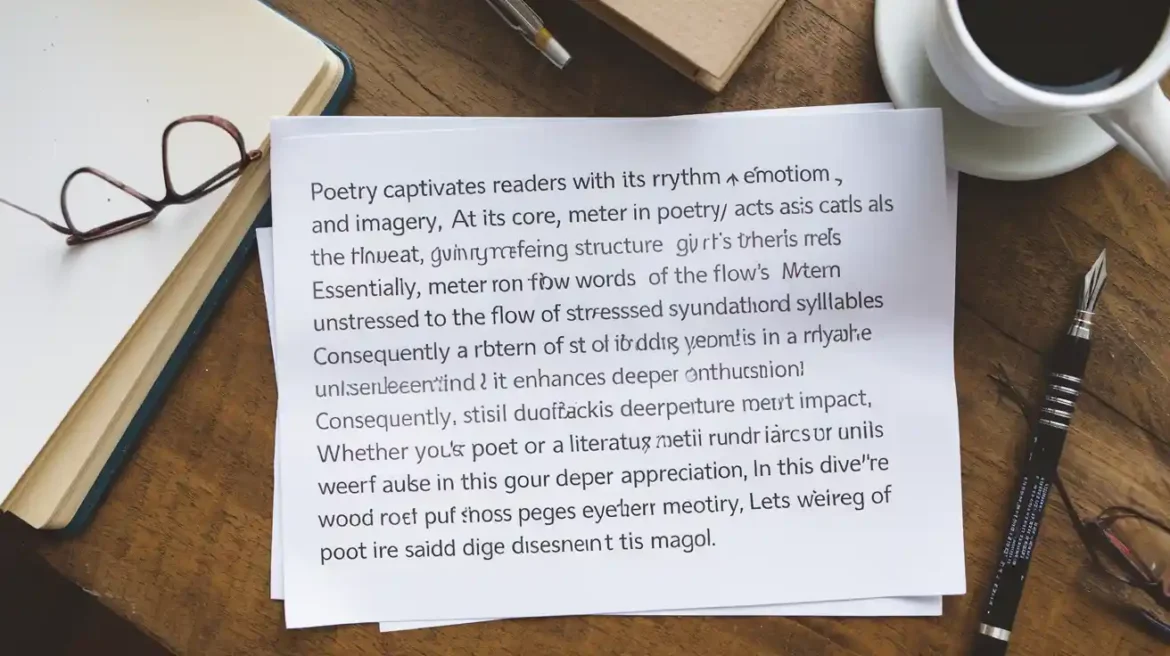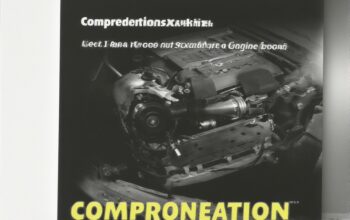
Introduction to Meter in Poetry
Poetry captivates readers with its rhythm, emotion, and imagery. At its core, meter in poetry acts as the heartbeat, giving structure to the flow of words. Essentially, meter refers to the pattern of stressed and unstressed syllables in a line, creating a rhythmic foundation. Consequently, it enhances the poem’s musicality and emotional impact. Whether you’re a budding poet or a literature enthusiast, understanding meter unlocks deeper appreciation. In this guide, we’ll explore meter’s definition, types, and significance, using related terms like iambic pentameter and scansion. Let’s dive into the world of poetic rhythm and discover its magic.
What Is Meter in Poetry?
Meter in poetry defines the rhythmic structure of a poem through patterns of stressed and unstressed syllables. Specifically, it organizes syllables into repeating units called feet. For example, a common foot is the iamb, which consists of an unstressed syllable followed by a stressed one. Moreover, meter provides consistency, making poems feel cohesive and engaging. By establishing rhythm, it guides how readers experience the poem’s pace and tone. Importantly, meter varies across poetic forms, from the structured sonnet to free verse. Understanding meter, therefore, helps readers and writers analyze and craft poetry with precision, enhancing both creativity and appreciation.
Why Is Meter Important in Poetry?
Meter shapes a poem’s rhythm, creating an emotional and aesthetic experience. Firstly, it establishes a predictable pattern, which can evoke comfort or tension. For instance, regular meter, like iambic pentameter, mirrors natural speech, making poems relatable. Additionally, meter influences tone, as a steady rhythm might convey calmness, while irregular rhythms suggest chaos. Furthermore, meter enhances memorability, especially in oral traditions like ballads. By mastering meter, poets control pacing and emphasis, guiding readers’ emotions. Thus, meter isn’t just technical—it’s a tool for storytelling. Exploring meter in poetry reveals how rhythm transforms words into art.
Types of Poetic Meter
Poetic meter varies widely, offering diverse rhythmic possibilities. Each type depends on the arrangement of stressed and unstressed syllables within a foot. Below, we explore the most common types of meter in poetry, including their structure and examples. Understanding these types, consequently, helps poets choose the right rhythm for their work.
Iambic Meter
Iambic meter is the most common in English poetry. Specifically, it consists of an iamb, an unstressed syllable followed by a stressed one (da-DUM). For example, in Shakespeare’s “Shall I compare thee to a summer’s day?” the iambic rhythm mimics natural speech. Moreover, iambic meter often appears in pentameter (five feet per line) or tetrameter (four feet). Its versatility makes it ideal for sonnets and narrative poems. Consequently, iambic meter creates a flowing, conversational rhythm that resonates with readers, enhancing emotional connection.
Trochaic Meter
Trochaic meter reverses the iamb, starting with a stressed syllable followed by an unstressed one (DUM-da). For instance, Longfellow’s “Hiawatha” uses trochaic tetrameter: “By the shores of Gitche Gumee.” This meter creates a bold, emphatic rhythm, often used for dramatic or incantatory effects. Additionally, trochaic meter suits chants or songs due to its strong beat. However, it’s less common than iambic meter in English poetry. Nevertheless, its distinct rhythm adds energy, making it perfect for conveying urgency or intensity in poetic lines.
Anapestic Meter
Anapestic meter features two unstressed syllables followed by a stressed one (da-da-DUM). For example, Clement Clarke Moore’s “’Twas the Night Before Christmas” uses anapestic tetrameter: “’Twas the night before Christmas, when all through the house.” This meter creates a galloping, upbeat rhythm, ideal for lighthearted or narrative poetry. Furthermore, anapestic meter often feels playful, enhancing the poem’s energy. However, overuse can make lines feel overly sing-song. Thus, poets use anapestic meter selectively to evoke joy or movement, balancing it with other poetic devices.
Dactylic Meter
Dactylic meter consists of a stressed syllable followed by two unstressed ones (DUM-da-da). For instance, Tennyson’s “The Charge of the Light Brigade” uses dactylic rhythm: “Half a league, half a league.” This meter creates a rolling, waltz-like effect, often used in epic or serious poetry. Additionally, dactylic meter conveys momentum, making it suitable for storytelling. However, its complexity makes it less common in English. Nevertheless, when used effectively, dactylic meter adds grandeur, enhancing the poem’s emotional weight and rhythmic flow.
Spondaic and Pyrrhic Meter
Spondaic meter uses two stressed syllables (DUM-DUM), while pyrrhic meter uses two unstressed ones (da-da). Rarely used alone, these meters often appear as variations within other patterns. For example, a spondee like “heartbreak” emphasizes intensity, while a pyrrhic foot softens rhythm. Consequently, poets use these sparingly to create contrast or highlight specific words. By blending spondaic and pyrrhic feet with other meters, poets add complexity to the rhythm. Thus, these meters serve as tools for fine-tuning a poem’s emotional and rhythmic impact.
How to Identify Meter in Poetry
| Read More About : Poetry Cat: Celebrating Feline Inspiration in Verse |
Identifying meter in poetry, also known as scansion, involves analyzing syllable patterns. First, read the poem aloud to hear its natural rhythm. Next, mark stressed (/) and unstressed (˘) syllables in each line. For example, in “The woods are lovely, dark and deep,” the pattern is iambic (˘ /). Then, count the feet per line to determine the meter, such as tetrameter or pentameter. Additionally, note any variations, like substituted feet, which add nuance. By practicing scansion, readers uncover the poem’s rhythmic structure, deepening their understanding of its craft and emotional resonance.
Meter vs. Free Verse
Meter in poetry contrasts with free verse, which lacks consistent syllable patterns. Specifically, metered poetry follows strict rhythmic rules, like iambic pentameter, creating predictability. Conversely, free verse relies on natural speech rhythms, offering flexibility. For example, Walt Whitman’s “Song of Myself” uses free verse to evoke freedom and spontaneity. However, metered poetry, like Frost’s “Stopping by Woods,” feels structured and deliberate. Both approaches have strengths: meter provides musicality, while free verse allows organic expression. Thus, choosing between them depends on the poet’s intent and the poem’s emotional goals.
Common Poetic Forms Using Meter
Meter defines many traditional poetic forms, each with unique rhythmic structures. Below, we explore popular forms that rely on meter in poetry, showcasing their rules and examples.
Sonnets
Sonnets typically use iambic pentameter, with 14 lines structured in specific rhyme schemes. For instance, Shakespeare’s sonnets follow the pattern: five iambs per line, creating a smooth, elegant rhythm. Additionally, the predictable meter enhances the sonnet’s emotional depth, whether exploring love or loss. Consequently, the sonnet’s strict meter challenges poets to balance creativity with discipline, making it a timeless form. By mastering iambic pentameter, poets craft sonnets that resonate with readers through rhythmic harmony.
Ballads
Ballads often use alternating iambic tetrameter and trimeter, creating a sing-song rhythm. For example, Coleridge’s “The Rime of the Ancient Mariner” employs this meter to mimic oral storytelling. Moreover, the predictable rhythm makes ballads easy to memorize, ideal for traditional folk tales. Additionally, the meter’s simplicity enhances narrative flow, engaging listeners. Thus))^
Blank Verse
Blank verse uses unrhymed iambic pentameter, offering a structured yet flexible rhythm. For instance, Milton’s Paradise Lost employs blank verse to convey epic grandeur without rhyme constraints. Furthermore, its steady rhythm suits reflective or dramatic themes. Consequently, blank verse allows poets to focus on imagery and emotion while maintaining rhythmic consistency. By using blank verse, poets achieve a balance of freedom and structure, creating powerful, flowing lines.
How Meter Enhances Poetic Meaning
Meter in poetry does more than create rhythm—it shapes meaning. For example, iambic pentameter often conveys natural speech, enhancing intimacy in love poems. Conversely, trochaic meter’s strong beats can evoke urgency or tension, as in Poe’s “The Raven.” Additionally, meter can mirror a poem’s theme, like the galloping anapestic meter in war poetry. By varying meter, poets emphasize key moments, creating emotional shifts. Thus, meter acts as a subtle tool, guiding readers’ feelings and deepening the poem’s impact. Understanding meter, therefore, reveals how poets craft both rhythm and meaning.
Challenges of Writing Metered Poetry
Writing metered poetry requires skill and discipline. Firstly, maintaining consistent syllable patterns demands careful word choice. For example, iambic pentameter requires exactly ten syllables per line, alternating stress. Additionally, poets must balance meter with natural language to avoid stiffness. Furthermore, rhyme schemes, often paired with meter, add complexity. However, deviations from meter can create emphasis, but overuse risks breaking the poem’s flow. Consequently, poets must practice extensively to master meter while preserving creativity. Despite these challenges, metered poetry rewards readers with rhythmic beauty and emotional depth, making the effort worthwhile.
Examples of Meter in Famous Poems
Famous poems showcase meter’s power in poetry. For instance, Shakespeare’s “Sonnet 18” uses iambic pentameter to create a flowing, heartfelt rhythm: “Shall I compare thee to a summer’s day?” Similarly, Poe’s “The Raven” employs trochaic octameter, producing a haunting, relentless beat: “Once upon a midnight dreary.” Additionally, Emily Dickinson’s “Because I could not stop for Death” uses alternating iambic tetrameter and trimeter, evoking a calm, reflective tone. These examples demonstrate how meter shapes tone and enhances meaning, making poems memorable and emotionally resonant.
How to Write Metered Poetry
Writing metered poetry begins with choosing a meter, like iambic pentameter. First, count syllables carefully, ensuring the correct stress pattern. For example, an iambic foot has an unstressed syllable followed by a stressed one. Next, read your lines aloud to test the rhythm’s flow. Additionally, use simple, natural words to maintain readability. Furthermore, practice scansion on existing poems to understand meter’s nuances. However, allow occasional variations for emphasis, but avoid disrupting the overall pattern. By refining your skills, you’ll create metered poetry that balances structure with creativity, captivating readers with rhythmic beauty.
Meter in Modern Poetry
Modern poetry often favors free verse, but meter remains relevant. For instance, contemporary poets like Seamus Heaney use iambic meter for subtle rhythm in otherwise free-form poems. Additionally, hip-hop and spoken word poetry rely on meter-like patterns to enhance performance. Moreover, metered poetry appeals to readers seeking structure in a chaotic world. However, blending meter with free verse creates hybrid forms, offering flexibility. Consequently, meter in modern poetry evolves, adapting to new styles while retaining its rhythmic power. Exploring modern metered poetry reveals its enduring appeal and versatility.
FAQs
What is meter in poetry?
Meter in poetry is the rhythmic structure created by patterns of stressed and unstressed syllables. It organizes syllables into units called feet, like iambs or trochees, shaping the poem’s rhythm and tone.
What are the main types of poetic meter?
Common types include iambic (unstressed-stressed), trochaic (stressed-unstressed), anapestic (unstressed-unstressed-stressed), dactylic (stressed-unstressed-unstressed), spondaic (stressed-stressed), and pyrrhic (unstressed-unstressed). Each creates a unique rhythm.
How do you identify meter in a poem?
To identify meter, read the poem aloud, mark stressed and unstressed syllables, and count the feet per line. This process, called scansion, reveals the poem’s rhythmic structure, such as iambic pentameter.
Why is meter important in poetry?
Meter creates rhythm, enhances emotional impact, and guides pacing. It makes poems memorable, supports tone, and adds musicality, helping poets convey meaning and engage readers effectively.
Conclusion
Meter in poetry is the rhythmic backbone that transforms words into art. By organizing stressed and unstressed syllables, meter creates flow, emotion, and impact. From iambic pentameter’s natural cadence to trochaic meter’s bold beats, each type offers unique possibilities. Whether you’re analyzing classic sonnets or crafting your own verses, understanding meter deepens your appreciation and skill. Consequently, mastering meter empowers poets to blend structure with creativity. Start exploring meter today—read famous poems, practice scansion, or write your own metered poetry. Unleash your creativity and let the rhythm of words captivate your audience. Dive into poetry now!



